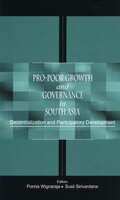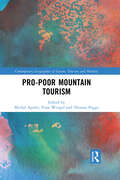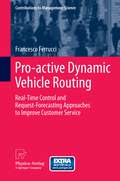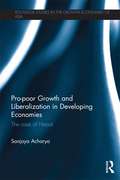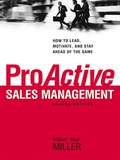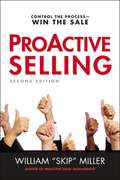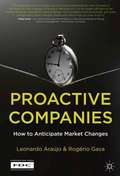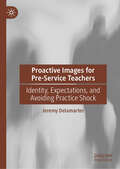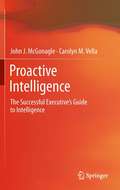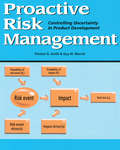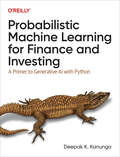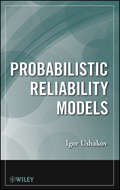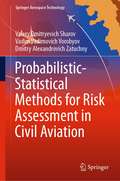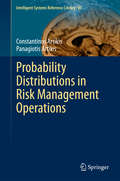- Table View
- List View
Pro-Poor Growth and Governance in South Asia: Decentralization and Participatory Development
by Ponna Wignaraja and Susil SirivardanaThis important volume advocates a pro-poor growth strategy where the poor also participate directly as subjects in development. The contributors maintain that a critical element in this process is social mobilization where organizations of the poor work in partnership with a restructured state and a socially responsible private sector. They see a new political space for this in the current attempts at decentralization which are also aimed at developing power to the people. To illustrate these possibilities, the volume presents six case studies from India, Pakistan, Sri Lanka, Nepal and Bangladesh. Together they show how new social movements and organizations of the poor are converging with efforts to decentralize and to share power at the local level. This volume breaks new ground by investigating in depth the three important agendas of governance, decentralization/devolution, and poverty eradication, and by highlighting how they can be coordinated to fashion a genuinely pro-poor macro—micro development strategy.
Pro-Poor Mountain Tourism (Contemporary Geographies of Leisure, Tourism and Mobility)
by Michal ApolloThis timely and interdisciplinary book is the first to examine mountain tourism and local communities with a pro-poor lens. By drawing on human geography, political and social science, ethics and moral philosophy and empirical research, the volume explores how mountain tourism can be used to fight poverty and inequality in mountain regions.Mountain tourism represents a growing mass tourism phenomenon. The local population, recognizing the possibilities for increased income, started to develop in situ services. However, sensitive to outside influences, the environment of high-altitude mountain areas resident communities have been abruptly exposed to impacts from mountain tourism-related activities, although until recently, they have been cut off from civilization. The natural environment and people living in mountain regions have been affected by an increasing number of visitors in the last few decades. Hence, this book provides an expert-led and comprehensive summary of mountain tourism development and illustrates how tourism can increase benefits for the poor within local communities. Furthermore, it presents updated management and governance policies.This volume will be of pivotal interest to scholars and practitioners from the fields of geography and tourism studies, ethics, and development economics, as well as policymakers, aid agencies, and general readers interested in sustainable development in mountain regions.
Pro-Sumer Power II! How to Create Wealth by Being Smarter, Not Cheaper, and Referring Others to Do the Same
by Bill QuainAccording to marketing expert Dr. Bill Quain, average people can produce above-average wealth through the power of pro-suming. Pro-sumer Power! is a must read for people who would love to create income - instead of "out-go" - when they shop.
Pro-active Dynamic Vehicle Routing
by Francesco FerrucciThis book deals with transportation processes denoted as the Real-time Distribution of Perishable Goods (RDOPG). The book presents three contributions that are made to the field of transportation. First, a model considering the minimization of customer inconvenience is formulated. Second, a pro-active real-time control approach is proposed. Stochastic knowledge is generated from past request information by a new forecasting approach and is used in the pro-active approach to guide vehicles to request-likely areas before real requests arrive there. Various computational results are presented to show that in many cases the pro-active approach is able to achieve significantly improved results. Moreover, a measure for determining the structural quality of request data sets is also proposed. The third contribution of this book is a method that is presented for considering driver inconvenience aspects which arise from vehicle en-route diversion activities. Specifically, this method makes it possible to restrict the number of performed vehicle en-route diversion activities.
Pro-forma-Kennzahlen in der Berichterstattung kapitalmarktorientierter Unternehmen: Literaturüberblick und empirische Evidenz
by Lars SchiemannPro-forma-Kennzahlen sind mittlerweile ein etablierter Teil der externen Berichterstattung kapitalmarktorientierter Unternehmen. Dabei handelt es sich um nicht regulierte Erfolgskennzahlen, die um Sondereffekte bereinigt sind. Ein so ermitteltes Ergebnis enthält zwar potentiell entscheidungsnützliche Informationen für Investoren, kann aber auch strategisch berichtet werden, um die Ertragslage eines Unternehmens vorteilhaft darzustellen. In der vorliegenden Arbeit werden zunächst die Forschungsergebnisse der letzten 20 Jahre systematisiert. Danach folgen zwei eigene empirische Studien anhand von deutschen Geschäftsberichten und Pressemitteilungen. Studie 1 untersucht die Qualität der Überleitungsrechnungen in den Jahren nach der Regulierung. Studie 2 untersucht die Determinanten der Berichterstattung und Betonung von Pro-forma-Kennzahlen.
Pro-poor Growth and Liberalization in Developing Economies: The Case of Nepal (Routledge Studies in the Growth Economies of Asia)
by Sanjaya AcharyaBy looking at the link between trade liberalization and pro-poor growth in Nepal, this book explores how a developing and transition economy can attain higher and pro-poor growth along with the ongoing trend of globalization. The author develops a social accounting database for Nepal and applies it to quantify computable general equilibrium (CGE) model to investigate the trade-offs between growth and distribution that are associated with opening up the economy and deregulating it. The book presents a number of pragmatic scenarios that bring about the desired pro-poor growth effects in order to demonstrate possible outcomes for policy making. The research findings apply to other economies with similar macroeconomic structure to Nepal; those small economies with a dominant, traditional, and stagnant agriculture; fragile industrial base, weak and volatile external sector, and almost half of the population living below the poverty line. This book will be of considerable interest to students and scholars in the areas of development economics, political economy of policy reforms, and trade and poverty with special emphasis on South Asia.
ProActive Sales Management: How to Lead, Motivate, and Stay Ahead of the Game
by William MillerAs the president of a major sales company and experienced sales management trainer, author William Miller provides sales managers a proven method for successfully managing both sales processes and salespeople.Packed with specific, field-tested techniques, ProActive Sales Management teaches you how to:motivate a sales team;get your sales team to prospect and qualify;create a proactive sales culture;effectively coach and counsel up and down the sales organization;reduce reports to one sheet of paper and 10 minutes a week;forecast with up to 90 percent accuracy;and take A players to A+ levels.Today&’s sales managers have to be quicker than ever, being more proactive about hiring the best performers and retaining them while multitasking with managing complex sales processes in order to close more deals.Filled with all new metrics and tactics for making the numbers in today&’s sales environment, ProActive Sales Management is an invaluable resource for this brand of highly in-demand leaders.
ProActive Selling: Control the Process--Win the Sale
by William MillerTrue sales pros know they must tailor their methods to the buyer if they want to make their numbers every year.Featuring dozens of enlightening examples, this book gives you the tools to adapt your approach with the buyers in mind and maintain control at every stage of the sale.In ProActive Selling, author William Miller shows salespeople how to:qualify and disqualify prospects sooner,shift their focus to the most promising accounts,examine buyers' motivations from every angle,quantify the value proposition early,double the number of calls returned from prospective customers,appeal to the real decision-makers,use technology (e.g. cloud, video, social media, etc) to generate leads and shorten sales cycles, and increase the effectiveness of every interaction.Most sales professionals make the mistake of using the same sales patterns over and over. With an essential understanding about the different needs of customers, this revised and updated second edition of ProActive Selling equips you to succeed with any company, in any industry.
Proactive Companies: How to Anticipate Market Changes
by Leonardo Araújo Rogério GavaWhy do some companies succeed better than others? It is well known that there are many variables such which may impact a company's performance. The authors present their new model for Market Proactiveness which shows organizations how to anticipate change and respond to it before they are forced to do so, and improve their overall performance.
Proactive Images for Pre-Service Teachers: Identity, Expectations, and Avoiding Practice Shock
by Jeremy DelamarterThis book provides tools to help pre-service teachers and teacher-preparation programs identify, evaluate, and respond to misaligned expectations early in the teacher-preparation sequence. Plato tells the story of prisoners who mistake the shadows on the wall of their cave for flesh-and-blood reality. These “shadow narratives” dominated their expectations, and when confronted with a three-dimensional reality that bore little resemblance to the shadows, the prisoners were blinded by the light. Surrounded by images and rhetoric that reduce the fullness of teaching to flat, two-dimensional representations, today's pre-service teachers tend to develop expectations of teaching that resemble the shadows more than they resemble reality. These misaligned expectations often lead to practice shock: the painful and disillusioning cognitive dissonance that comes about when unsustainable expectations collide with real-world practice. Intended as a proactive manual for mitigating practice shock, this book shines a light on the shadows by giving pre-service teachers the tools to examine, confront, and revise their own misaligned expectations of teaching before they reach the point of crisis.
Proactive Intelligence
by John J. Mcgonagle Carolyn M. VellaTraditionally, tapping into the power of competitive intelligence (CI) meant investing in the development of an internal CI unit or hiring outside consultants who specialized in CI. Proactive Intelligence: The Successful Executive's Guide to Intelligence offers an alternative: learn how to do it yourself and how to effectively manage the parts you cannot. The tools and techniques that will enable you to produce your own CI for your consumption are out there, and have been honed by decades of work. But, you cannot just adopt them - you have to adapt them. Why? Because, when you finish reading this book, you will be the data collector, the analyst, and the end-user. Traditional CI is premised on a reactive, two part relationship - a CI professional responding to what an end-user identifies as a need; by doing this yourself you can turn CI from being reactive to being proactive. As the decision-maker, you can get what CI you need, when you need it, and then use it almost seamlessly. Written by two of the foremost experts on CI, Proactive Intelligence: The Successful Executive's Guide to Intelligence: shows where and how CI can help you and your firm, provides practical guidance on how to identify what CI you need, how to find the data you need, and how to analyze it, and discusses how to apply CI to develop competitive- and career- advantages. Each chapter is supported by important references as well as by an additional list of resources to support and supplement your knowledge. Proactive Intelligence: The Successful Executive's Guide to Intelligence teaches you how to generate proactive intelligence and use it to advance your business and your career- making it an essential resource for managers and executives, as well as everyone who wishes to integrate CI into their daily work routine.
Proactive Law for Managers: A Hidden Source of Competitive Advantage
by Helena Haapio George SiedelSavvy managers no longer look at contracts and the law reactively but use them proactively to reduce their costs, minimize their risks, secure key talent, collaborate to innovate, protect intellectual property, and create value for their customers that is superior to that offered by competitors. To achieve competitive advantage in this way managers need a plan. Proactive Law for Managers provides this plan; The Manager's Legal PlanTM. George Siedel and Helena Haapio first discuss the traditional, reactive approach used by many managers when confronted with the law, then contrast it with a proactive approach that enables the law and managers' legal capabilities to be used to prevent problems, promote successful business, and achieve competitive advantage. Proactive Law for Managers shows how to use contracts and the law to create new value and innovate in often neglected areas - and implement ideas in a profitable manner.
Proactive Police Management
by Edward A. Thibault Lawrence M. Lynch R. Bruce McbridePolice managers anticipating events through planning, using police personnel and resources effectively.
Proactive Risk Management: Controlling Uncertainty in Product Development
by Preston G. Smith Guy M. MerrittListed as one of the 30 Best Business Books of 2002 by Executive Book Summaries. Proactive Risk Management's unique approach provides a model of risk that is scalable to any size project or program and easily deployable into any product development or project management life cycle. It offers methods for identifying drivers (causes) of risks so you can manage root causes rather than the symptoms of risks. Providing you with an appropriate quantification of the key factors of a risk allows you to prioritize those risks without introducing errors that render the numbers meaningless. This book stands apart from much of the literature on project risk management in its practical, easy-to-use, fact-based approach to managing all of the risks associated with a project. The depth of actual how-to information and techniques provided here is not available anywhere else.
Proaktive Marketing- und Vertriebs-Impulse: Content, Automatisierung, KI, Daten & Trends – worauf sich das B2B- und B2C-Business vorbereiten müssen
by Olaf MörkDieses Buch für Marketing- und Vertriebs-Entscheider entwirrt die komplexen Veränderungen, die auf Unternehmen zurollen. Der Autor zeigt, welche technischen und kommunikativen Herausforderungen für B2B- und B2C-Unternehmen anstehen, wie Strategien für die Zukunft aufgestellt und wie sie umgesetzt werden können.Die großen Trends der letzten Jahre stoßen an ihre Wachstumsgrenzen und die Explosion der Angebote im MarTech-Bereich hat vielfach zur Verwirrung geführt. Jetzt klopfen weitere, neue Trends aus der digitalen Welt an (Generative AI, Avatare, Composability, ...).Wie gewinnen Marketingabteilungen in diesem Technologie- und Content-Dschungel die Aufmerksamkeit ihrer Kunden und behalten selber den Überblick? Olaf Mörk analysiert dafür die relevanten Trends. Dieses Buch – mit zahlreichen Praxisbeispielen (z. B. 1.000 % mehr Leads), Abbildungen und Tipps – ist eine wertvolle Inspirationsquelle für alle, die sich für die Herausforderungen in Marketing und Vertrieb der kommenden Jahre rüsten wollen.Aus dem InhaltDas geänderte Informationsverhalten von Gen Y und Gen Z fordern Marketing und Vertrieb herausNeueste Trends verstehen und nutzen: Virtuelle-Influencer, ChatGPT, KI-Agents, Internet of Think (IoTK), Avatare, Web3, Composability, Cognitive Computing, Super-Apps und Social MediaSituatives-Content-Marketing (SCM), Social Selling und New Sales LeadershipGemeinsam zum Erfolg: das Erfolgstrio Marketing + Vertrieb + CDO Marketing Automation, Big Data und Data Governance – Chancen und Herausforderungen LinkedIn als effektives B2B-Social-Media-Netzwerk: Praktische Tipps und TricksMit einem Geleitwort René Kühn, Initiator von CMCX/Content-Marketing.Com
Proaktive Polizeiarbeit als Führungs- und Managementaufgabe: Grundlagen - Praxis - Perspektiven
by Christian BarthelDieser Sammelband zeigt, wie Bürgerorientierung und proaktive Polizeiarbeit im Organisationsalltag der Dienststellen wirksam und vor allem auf Dauer sichergestellt werden können. Beides gehört heute zum Selbstverständnis der Polizei, dennoch spielt Prävention im Alltag polizeilicher Dienststellen oft genug eine Nebenrolle. Zuspitzend könnte man sagen: Die Rede von der Bürgerorientierung dient mitunter zur Dekoration der Außen- und Schauseite der Organisation und die operative Beschäftigung mit der konkreten Präventionsarbeit, dem Dialog mit Bürgern und Sicherheitspartnern wird an die stellenmäßig gering ausgestatteten Kontaktbereichsbeamten delegiert. Die Autoren machen in ihren Beiträgen deutlich, wie entscheidend Führung für den Erfolg bürgerorientierter Polizeiarbeit ist. Führung und Management auf der Leitungsebene von Polizeiinspektionen, Revieren, Kommissariaten – also den Basisorganisationseinheiten der Polizei in der Fläche - sind die Bedingungen der Möglichkeit einer bürgerorientierten, präventiven und proaktiven Polizeiarbeit. Die Führungskräfte des Höheren Dienstes müssen die treibende Kraft für die strategische Ausrichtung und Entwicklung der Dienststelle sein, die erst die Bürgerorientierung als klugen Mix des gesamten polizeilichen Interventionsrepertoires gewährleistet.
Probabilistic Machine Learning for Finance and Investing: A Primer to Generative AI with Python
by Deepak K. KanungoThere are several reasons why probabilistic machine learning represents the next-generation ML framework and technology for finance and investing. This generative ensemble learns continually from small and noisy financial datasets while seamlessly enabling probabilistic inference, retrodiction, prediction, and counterfactual reasoning. Probabilistic ML also lets you systematically encode personal, empirical, and institutional knowledge into ML models.Whether they're based on academic theories or ML strategies, all financial models are subject to modeling errors that can be mitigated but not eliminated. Probabilistic ML systems treat uncertainties and errors of financial and investing systems as features, not bugs. And they quantify uncertainty generated from inexact inputs and outputs as probability distributions, not point estimates. This makes for realistic financial inferences and predictions that are useful for decision-making and risk management.Unlike conventional AI, these systems are capable of warning us when their inferences and predictions are no longer useful in the current market environment. By moving away from flawed statistical methodologies and a restrictive conventional view of probability as a limiting frequency, you’ll move toward an intuitive view of probability as logic within an axiomatic statistical framework that comprehensively and successfully quantifies uncertainty. This book shows you how.
Probabilistic Reliability Models
by Igor A. UshakovPractical Approaches to Reliability Theory in Cutting-Edge ApplicationsProbabilistic Reliability Models helps readers understand and properly use statistical methodsand optimal resource allocation to solve engineering problems.The author supplies engineers with a deeper understanding of mathematical models while alsoequipping mathematically oriented readers with a fundamental knowledge of the engineeringrelatedapplications at the center of model building. The book showcases the use of probabilitytheory and mathematical statistics to solve common, real-world reliability problems. Followingan introduction to the topic, subsequent chapters explore key systems and models including:* Unrecoverable objects and recoverable systems* Methods of direct enumeration* Markov models and heuristic models* Performance effectiveness* Time redundancy* System survivability* Aging units and their related systems* Multistate systemsDetailed case studies illustrate the relevance of the discussed methods to real-world technicalprojects including software failure avalanches, gas pipelines with underground storage, andintercontinental ballistic missile (ICBM) control systems. Numerical examples and detailedexplanations accompany each topic, and exercises throughout allow readers to test theircomprehension of the presented material.Probabilistic Reliability Models is an excellent book for statistics, engineering, and operationsresearch courses on applied probability at the upper-undergraduate and graduate levels. Thebook is also a valuable reference for professionals and researchers working in industry whowould like a mathematical review of reliability models and the relevant applications.
Probabilistic Theory of Mean Field Games with Applications I: Mean Field FBSDEs, Control, and Games (Probability Theory and Stochastic Modelling #83)
by René Carmona François DelarueThis two-volume book offers a comprehensive treatment of the probabilistic approach to mean field game models and their applications. The book is self-contained in nature and includes original material and applications with explicit examples throughout, including numerical solutions.Volume I of the book is entirely devoted to the theory of mean field games without a common noise. The first half of the volume provides a self-contained introduction to mean field games, starting from concrete illustrations of games with a finite number of players, and ending with ready-for-use solvability results. Readers are provided with the tools necessary for the solution of forward-backward stochastic differential equations of the McKean-Vlasov type at the core of the probabilistic approach. The second half of this volume focuses on the main principles of analysis on the Wasserstein space. It includes Lions' approach to the Wasserstein differential calculus, and the applications of its results to the analysis of stochastic mean field control problems. Together, both Volume I and Volume II will greatly benefit mathematical graduate students and researchers interested in mean field games. The authors provide a detailed road map through the book allowing different access points for different readers and building up the level of technical detail. The accessible approach and overview will allow interested researchers in the applied sciences to obtain a clear overview of the state of the art in mean field games.
Probabilistic Theory of Mean Field Games with Applications II: Mean Field Games with Common Noise and Master Equations (Probability Theory and Stochastic Modelling #84)
by René Carmona François DelarueThis two-volume book offers a comprehensive treatment of the probabilistic approach to mean field game models and their applications. The book is self-contained in nature and includes original material and applications with explicit examples throughout, including numerical solutions. Volume II tackles the analysis of mean field games in which the players are affected by a common source of noise. The first part of the volume introduces and studies the concepts of weak and strong equilibria, and establishes general solvability results. The second part is devoted to the study of the master equation, a partial differential equation satisfied by the value function of the game over the space of probability measures. Existence of viscosity and classical solutions are proven and used to study asymptotics of games with finitely many players. Together, both Volume I and Volume II will greatly benefit mathematical graduate students and researchers interested in mean field games. The authors provide a detailed road map through the book allowing different access points for different readers and building up the level of technical detail. The accessible approach and overview will allow interested researchers in the applied sciences to obtain a clear overview of the state of the art in mean field games.
Probabilistic-Statistical Methods for Risk Assessment in Civil Aviation (Springer Aerospace Technology)
by Dmitry Alexandrovich Zatuchny Valery Dmitryevich Sharov Vadim Vadimovich VorobyovThis book analyses the models for major risks related to flight safety in the aviation sector and presents risk estimation methods through examples of several known aviation enterprises. The book provides a comprehensive content for professionals engaged in the development of flight safety regulatory framework as well as in the design and operation of ground-based or on-board flight support radio electronic systems. The book is also useful for senior students and postgraduates in aviation specialties, especially those related to air traffic management.
Probability Distributions
by Michael Parzen Paul J. HamiltonThis technical note introduces students to the concept of random variables, and from there the normal and binomial distributions. After a brief introduction to random variables, the note describes the standard properties of the normal distribution: a single peak, and a symmetric, bell-shaped curve. Students observe the 68-95-99.7 rule, and see how the distribution changes with different values of the mean and standard deviation parameters. Finally, the note demonstrates how probability calculations based on the normal distribution can be done in the R programming language, and how random data can be simulated from a normal curve in R. The note then describes the standard properties of the binomial distribution, and similarly shows how binomial calculations can be performed in R.
Probability Distributions in Risk Management Operations
by Constantinos Artikis Panagiotis ArtikisThis book is about the formulations, theoretical investigations, and practical applications of new stochastic models for fundamental concepts and operations of the discipline of risk management. It also examines how these models can be useful in the descriptions, measurements, evaluations, and treatments of risks threatening various modern organizations. Moreover, the book makes clear that such stochastic models constitute very strong analytical tools which substantially facilitate strategic thinking and strategic decision making in many significant areas of risk management. In particular the incorporation of fundamental probabilistic concepts such as the sum, minimum, and maximum of a random number of continuous, positive, independent, and identically distributed random variables in the mathematical structure of stochastic models significantly supports the suitability of these models in the developments, investigations, selections, and implementations of proactive and reactive risk management operations. The book makes extensive use of integral and differential equations of characteristic functions, mainly corresponding to important classes of mixtures of probability distributions, as powerful analytical tools for investigating the behavior of new stochastic models suitable for the descriptions and implementations of fundamental risk control and risk financing operations. These risk treatment operations very often arise in a wide variety of scientific disciplines of extreme practical importance.
Probability Foundations for Engineers
by Joel A. NachlasThis textbook will continue to be the best suitable textbook written specifically for a first course on probability theory and designed for industrial engineering and operations management students. The book offers theory in an accessible manner and includes numerous practical examples based on engineering applications. Probability Foundations for Engineers, Second Edition continues to focus specifically on probability rather than probability and statistics. It offers a conversational presentation rather than a theorem or proof and includes examples based on engineering applications as it highlights Excel computations. This new edition presents a review of set theory and updates all descriptions, such as events versus outcomes, so that they are more understandable. Additional new material includes distributions such as beta and lognormal, a section on counting principles for defining probabilities, a section on mixture distributions and a pair of distribution summary tables. Intended for undergraduate engineering students, this new edition textbook offers a foundational knowledge of probability. It is also useful to engineers already in the field who want to learn more about probability concepts. An updated solutions manual is available for qualified textbook adoptions.
Probability Foundations for Engineers
by Joel A. NachlasSuitable for a first course in probability theory, this textbook covers theory in an accessible manner and includes numerous practical examples based on engineering applications. The book begins with a summary of set theory and then introduces probability and its axioms. It covers conditional probability, independence, and approximations. An important aspect of the text is the fact that examples are not presented in terms of "balls in urns". Many examples do relate to gambling with coins, dice and cards but most are based on observable physical phenomena familiar to engineering students.
